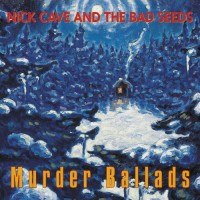In 1996, Nick Cave and the Bad Seeds released the album Murder Ballads. As the title indicates, the album was a collection of songs that fell into the murder ballad category. For those not versed in the song style, a murder ballad was a song within the traditional folk music genre that provided the details leading up to, during, and consequences of a murder. Nick Cave reinterpreted l traditional murder ballads on this album, in addition to composing several of his own.
               This was the album that broke Nick Cave and the Bad Seeds to the general public, driven largely by the first single on the release “Where the Wild Roses Grow†which was a duet with Australian pop singer Kylie Minogue. While failing to chart in the US, the song did appear in the Top 10 Weekly Singles Charts for twelve other countries. The song, which is a beautiful and melodic duet between Cave and Minogue, details an exchange between a killer (Cave) and his victim (Minogue). Although the song is rather grisly by pop song standards, which likely explains its lack of chart success in the US, it is easily the most accessible song on the album both musically and lyrically.
               While many people who picked up this album because of the aforementioned single were quick to find the rest of the album was quite different, they wouldn’t have been disappointed as this is one of the stronger albums in the Bad Seeds’ catalog. As many of tracks were far more graphic in their depiction of violence, with many also not fitting within the modern day depiction of the ballad. That being said, if they were fans of great music it wasn’t likely they’d be disappointed.
               Perhaps the most explicit song on the album is “Stagger Lee†which is Nick Cave’s take on the traditional folk song “Stagolee,†Cave’s version is perhaps one the most violent and sexually explicit songs in his repertoire. But, it isn’t meant as a violent novelty as it actually holds up amongst many of his best songs in its own rite. With lyrics touching on prostitution, oral sex, and some of the most vivid depictions of violence on the album, this song alone would made the album deserving of a Parental Advisory sticker in post P.M.R.C America. However the album appeared to fly under the radar, in that regard, when it first hit shelves stateside.
               While nearly every song on the album shows the band operating in top form, when the band really succeeds is when Cave is able to delve head on into storytelling such as on “The Curse of Millhaven.†Where the song depicts grisly acts of violence, but also shows the protagonist’s thought after the event, which are every bit as grisly and full on sociopathic. “O’Malley’s Bar†a few tracks later keep the sociopathic tones rolling as Cave laments how “if I have no free will, how can I be morally culpable?†While every song touches on acts of murder, these two are perhaps the most vivid depictions of not only the act of taking a life itself. But, also these songs also focus on the mindset of the songs’ protagonist immediately following the act.
               Another important item of note, in regard to this album, is the musical progression of the band. While the Bad Seeds had long ago moved away from the near musical chaos of The Birthday Party, they’d never experimented with melody the way they had on this album. And if you look at the albums to follow it, The Boatman’s Call and No More Shall We Part the overall feel of the band drifted from dwindling on the brink of chaos to piano driven lovelorn ballads. While Cave’s personal life certainly played a role in this, the band being able to hold the sound required to back the lyrics on those albums got its start here.
               There
are certainly more albums in the Nick Cave catalog that outdo this one,
especially if you prefer you Bad Seeds teetering on the brink of total chaos. This
album, however, is what made later era Nick Cave possible. Which makes this,
perhaps, one of the most fully realized transitional albums of the
mid-nineties. While by no means as influential as some their early work, and
certainly not as melodic as what was to come; this album will most likely
remain the most musically pivotal release in Nick Cave’s storied music career.Â
